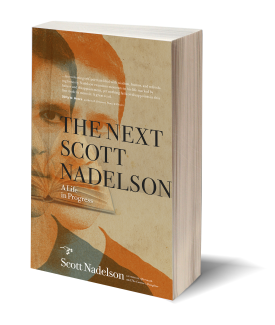|
 |
|---|
Reviewed by Andrew Scott
What qualities does the work of a writer's writer typically exhibit? The designation conveys one fiction writer's high opinion of another author's work, but it also carries an undercurrent of dashed dreams and despair. Writers crave the approval of peers, but also hope to rise above such a constrictive label. Often, but not always, a writer's writer is primarily (or exclusively) a writer of short stories. At minimum, a writer's writer—the "definition of obscurity," according to Deborah Treisman, fiction editor of The New Yorker—does not reach the sizable audience he or she so richly deserves, despite placing work in respected literary periodicals and receiving a variety of awards. Operating in obscurity has its benefits, however: a writer's writer often takes narrative risks that leave other capable writers agape with wonder. Your task, ladies and gentlemen of the jury, is to decide: Is Scott Nadelson a writer's writer?
Exhibit A
Aftermath is Scott Nadelson's third short-story collection. His previous books, The Cantor's Daughter: Stories and Saving Stanley: The Brickman Stories, each gathered impressive accolades, among them the Great Lakes Colleges Association New Writers Award and the Samuel Goldberg & Sons Fiction Prize for Emerging Jewish Writers. His fiction and nonfiction have been published in New England Review, Alaska Quarterly Review, Post Road, Ploughshares, the Southern Review, Glimmer Train Stories, Puerto del Sol, and other top-shelf literary journals.
Exhibit B
In a self-interview for The Nervous Breakdown, Nadelson explains: "Whatever else I may be working on—and I'll admit, I usually write a draft or two of a terrible novel between every story collection—I'm first and foremost a story writer. I claim the title proudly and often argue that the story be considered a different genre entirely than the novel, rather than its undersized cousin."
Exhibit C
Do you know the work of Scott Nadelson? Have you read one of his books? Until Aftermath, I had not.
Exhibits D-K
The eight stories in Aftermath utilize a deep sense of place to reveal character and crank up the tension. The book balances the sophisticated turmoil of inner lives with just enough engaging plot elements to keep readers turning pages. Nadelson is comfortable writing about his native New Jersey, but bold—and skillful—enough to offer a story set in Jerusalem without it seeming like the work of a tourist, even if the characters in that story ("Oslo") literally tour the city. His handling of time, especially, demonstrates how thoroughly the human experience is portrayed in these stories. A protagonist's sudden honeymoon memory comes to influence the present moment, while another character projects into the future, allowing readers an entirely different perspective, as time hasn't stopped for us. "'A year from now,' Alana said. 'We'll be getting ready to celebrate. Can you imagine it? President Howard Dean.'"
The collection's bookends—"Dolph Schayes's Broken Arm" and "West End"—are first-person narratives, but the six stories between them are told in the third person, a point of view that conveys Nadelson's easy authority as he delves into the private lives of young men, boys, and couples in the midst of trouble. Critics looking to cast these off as mere domestic stories will find expansive, worldly complications throughout; history, politics, and religion are just three of the Big Ideas swimming laps in these rippling pools.
But it is love, in its many forms, that is of central concern here, as suggested by the opening to "The Old Uniform," from the heart of this book:
Three nights after he called off the wedding and moved out of Stacey's condo, Adam put on the old uniform: black high-top Chuck Taylors, dark jeans with the cuffs rolled once, a maroon T-shirt printed with the fading logo of a trucking company, a battered leather jacket with a crumpled pack of stale cigarettes stuffed into the front pocket. Everything still fit, the jeans a little stiff, the sleeves of the jacket crackling when he stretched out his arms, and for the first time all week he believed, momentarily, that he might not have to suffer as deeply as he'd first imagined.
This passage illustrates a few of the collection's charms, not least of which is an acceptance that heartbreak and desolation can easily become the new normal, though a little humor ("Howard Dean") helps readers bear the struggles these characters endure in the aftermath of their choices. Adam in "The Old Uniform" certainly suffers, but the first line makes clear who called off the wedding.
Closing Argument
Most of these stories aren't all that short; several of the best stories in Aftermath are 25 pages or longer; the title story is more than 50 pages, and "West End" can rightly be called a novella. Nadelson is a fine maker of long stories, and has shown in his previous books a willingness to unify a collection beyond thematic concerns. With this in mind, it's hard to believe that a "terrible novel" drafted between those story collections hasn't yet risen past its revisions. Perhaps Nadelson, like many talented story writers before him, will slip into the novel's back room unnoticed—with another linked collection, a story cycle, or whatever the hell we're calling them these days. How many otherwise competent readers have you heard claim that they don't read short stories? A novel could bring him the attention he deserves, though an artful, accomplished writer like Nadelson ought to be able to sustain a respectable career on stories alone.
Ms. Treisman and others often forget that many writer's writers are finally pulled from the edges of obscurity. The career of Andre Dubus—who wrote long stories and novellas, published with a small but respectable outfit, and crafted two exquisite books of personal nonfiction—might be a guiding example for Scott Nadelson. Perhaps The New Yorker should pay attention to him. Perhaps you should.
